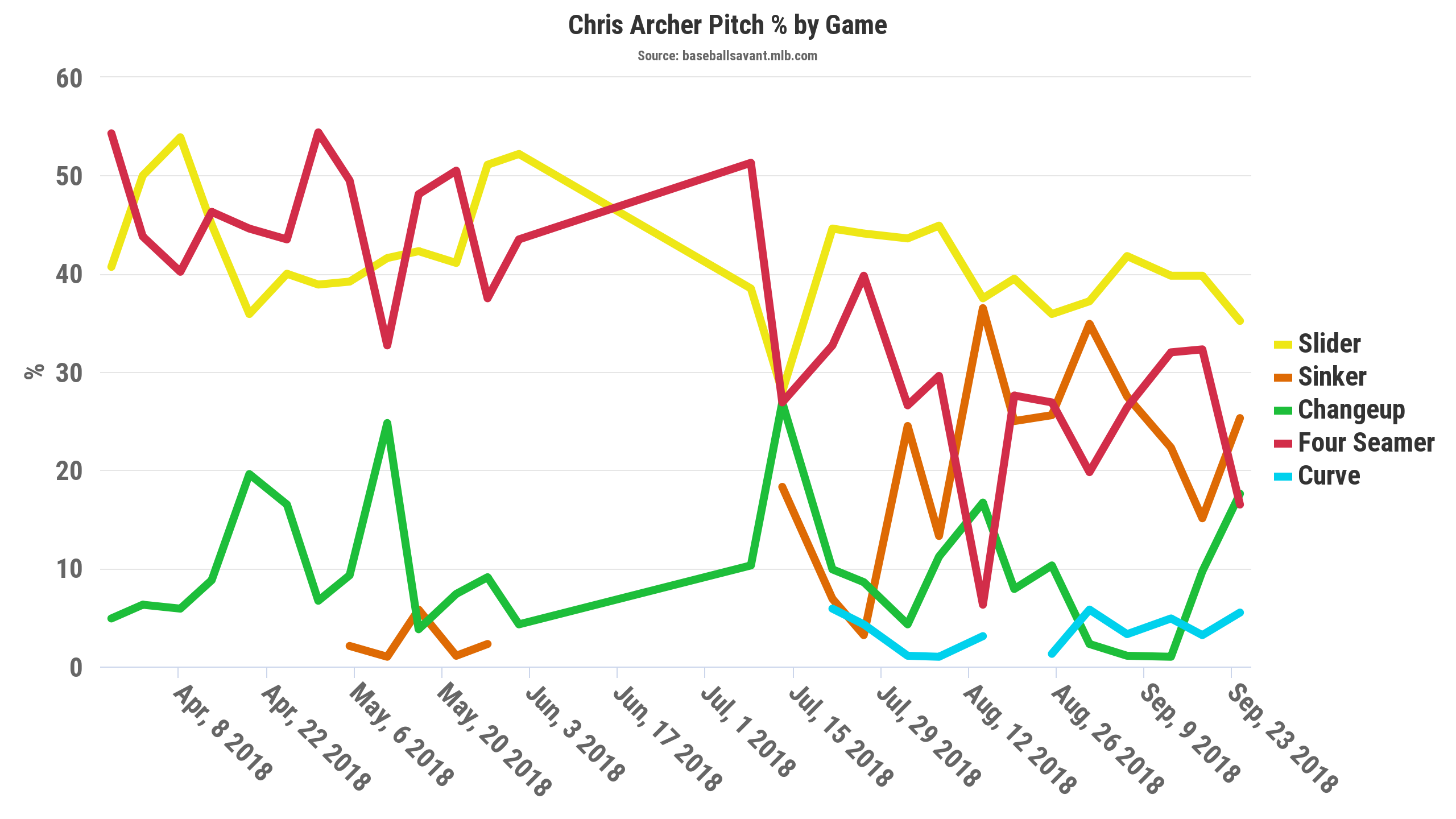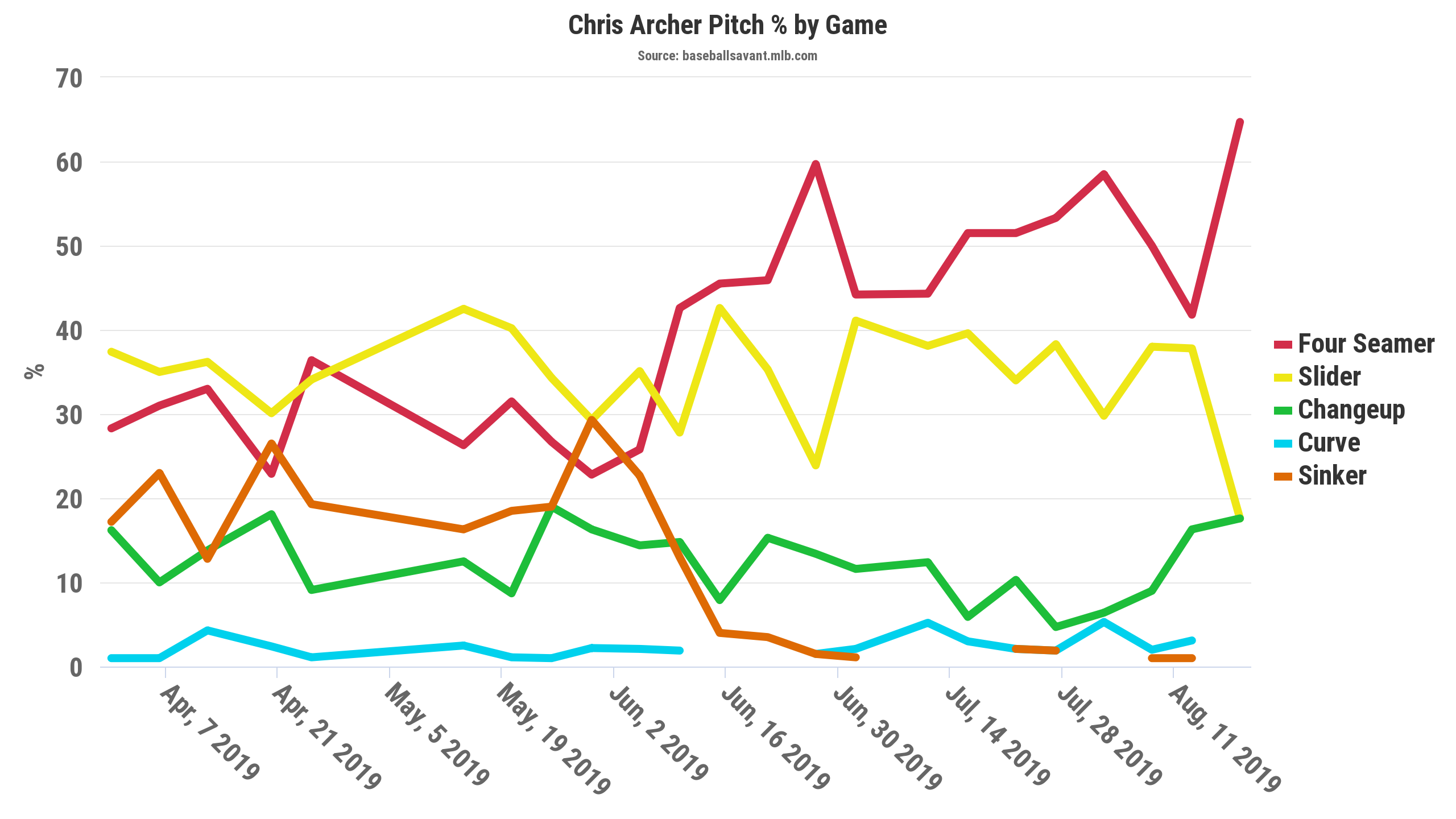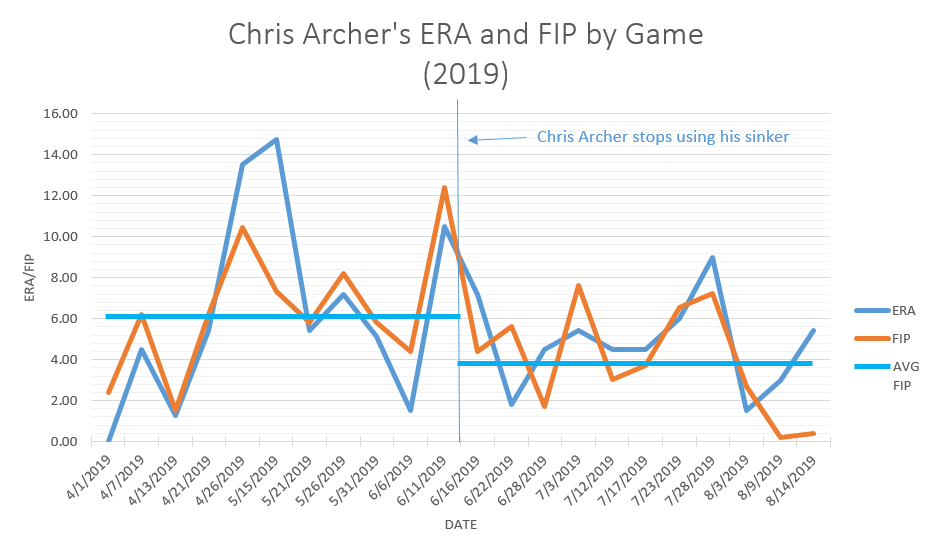If you were to make a list of some of the most frustrating and controversial players in fantasy, Chris Archer would surely make that list. Some say that he used to be a great pitcher but no longer is, and others argue that he wasn’t good to begin with. Adding fuel to this debate is his part in one of the most lopsided trades in baseball history, wherein the Rays traded a deteriorating Chris Archer for then rising/now current superstars Tyler Glasnow and Austin Meadows.
Archer’s 2014 and 2015 seasons were undoubtedly elite as he posted an ERA in the low threes, with a FIP to back it up in both years. Add 173 and 252 strikeouts on top of both of those seasons, respectively, and we’re suddenly entering ace territory. It’s hard to argue that Chris Archer was never good, but those who do probably tend to focus on his seasons after 2015. While 2016 and 2017 were far from disasters, Archer struggled with injuries in both 2018 and 2019, and his numbers downright collapsed in 2019. In his most recent campaign, he posted a ghastly 5.19 ERA, but he still had a solid 10.75 K/9 for the 119.2 innings he did pitch.
So where did it all go wrong? How does a pitcher with one of the filthiest sliders in the game and an elite strikeout ability—even as late as 2019—drop to an average ADP of 271.6 according to FantasyPros? Believe it or not, the answer is not that complicated, and the path to Archer regaining a semblance of his past form doesn’t even rely on him gaining any new skills.
The Good Old Days?
It seems like Archer’s elite form is such a distant memory to the point that it is often forgotten when Archer is characterized in contemporary fantasy discourse. Some will concede that he is a great strikeout pitcher, but it is not worth the ERA damage; Archer hasn’t had below a 4.00 ERA since 2015. However, he wasn’t always an ERA liability, and he still provided plenty of strikeouts. His 3.33 and 3.23 ERA in 2014 and 2015, respectively, were entirely backed up by a 3.39 and 2.90 FIP in those respective years. Even moving beyond those two undoubtedly great seasons, Archer remained solidly in the top realms of the xFIP leaderboard through his 2018 season.
| Year | xFIP | Rank |
|---|---|---|
| 2014 | 3.70 | 44th |
| 2015 | 3.01 | 8th |
| 2016 | 3.41 | 5th |
| 2017 | 3.35 | 11th |
| 2018 | 3.59 | 18th* |
| 2019 | 4.36 | 39th* |
* If he had the innings to qualify
To put this in context, look at the xFIP of a consensus elite pitcher, Max Scherzer, over the same time span. The numbers aren’t that glaringly different even though we’re talking about the difference between a first round player and an extremely late round player.
| Year | xFIP |
|---|---|
| 2014 | 3.12 |
| 2015 | 2.88 |
| 2016 | 3.37 |
| 2017 | 3.28 |
| 2018 | 3.06 |
| 2019 | 2.88 |
What made Archer so dominant was his filthy fastball-slider combination that led to a similarly elite swinging strike rate that also placed him in company with the best of the best pitchers. This even holds true through 2019!
| Year | SwStr% | Rank |
|---|---|---|
| 2014 | 9.3 | 38th |
| 2015 | 12.8 | 8th |
| 2016 | 12.2 | 8th |
| 2017 | 13.4 | 7th |
| 2018 | 13.1 | 10th |
| 2019 | 12.9 | T-14th |
But of course, his performance diminished greatly in his injury-riddled 2018 and 2019, posting a 4.31 and 5.19 ERA in those seasons, respectively. It’s pretty easy to see now why he is being drafted as nearly the 300th player off the board in 2020.
Why did he struggle so much in those two seasons? He did give up more homers and allow more walks in 2019. However, he always struggled with walks to some extent, and this increase in homers was despite a nearly identical hard hit rate to his previous two seasons. What Archer’s struggles can be pinned on is his awful sinker.
The Stinking Sinker
As we’ve seen, Archer’s dominance in results, albeit not really in skill, began waning in 2016. The floor completely fell out in 2018, and things went from bad to worse in 2019. Let’s look at Archer’s pitch usage in his 2018 and 2019 seasons.


As we can see, Archer started adding his sinker in the middle of the 2018 season right before he was traded to the Pirates. This usage didn’t fall off until the middle of his 2019 season.
Now, let’s look at the effectiveness of arguably his best pitch (slider) and his worst pitch (sinker).
| Season | BA | xBA | wOBA | xWOBA |
|---|---|---|---|---|
| 2015 | 0.188 | 0.185 | 0.224 | 0.226 |
| 2016 | 0.199 | 0.194 | 0.243 | 0.247 |
| 2017 | 0.214 | 0.198 | 0.260 | 0.247 |
| 2018 | 0.231 | 0.220 | 0.289 | 0.267 |
| 2019 | 0.233 | 0.230 | 0.305 | 0.295 |
| Season | BA | xBA | wOBA | xWOBA |
|---|---|---|---|---|
| 2018 | 0.327 | 0.267 | 0.396 | 0.367 |
| 2019 | 0.378 | 0.405 | 0.511 | 0.526 |
To break this down, those numbers on his slider are elite in the earlier seasons, and still solid in the later seasons. The expected stats entirely support the results, if not argue that they should be even better. It’s also entirely possible that the slight decline in his slider’s performance during his more recent seasons could be that he wasn’t exclusively complementing it with his fastball, rather complementing it with a bad sinker. In fact, let’s dive into that sinker. The results are shockingly bad, especially in 2019. It was a pitch that was simply not working for him in any way, shape, or form.
If that’s the case, why didn’t he eliminate it? Surely the Pirates are seeing these numbers as well. Well, the short answer is that he did remove the sinker from his arsenal later in 2019, and we’ll get to the results from that shortly. The longer answer is that the Pirates have been criticized by one of the former Pirates in the Archer trade, Tyler Glasnow, as having been behind the times in developing pitchers. Going forward, the Pirates have completely gutted their coaching staff, and it seems like the new pitching coach, Oscar Marin, is eager to modernize the Pirates’ coaching on the pitching side of things.
Now, let’s look at the numbers before and after Archer removed the sinker from his arsenal in his disastrous 2019, it actually begins to look a lot less disastrous. His average FIP comes out to be about 6.23 while he was still using his sinker, and about 3.90 after he stopped throwing the sinker, which I do not need to emphasize how massively different those results are.

The Future
It seems that Archer was committed to leaving his sinker in the past at the end of 2019, and with Marin’s analytics driven coaching beginning in 2020, it’s likely that it will remain a horrible relic in Archer’s past. This begs the question then of what Chris Archer can be going forward. As we saw before, Archer’s swinging strike rate floated around an elite 13% for almost his entire career, and his xFIP as recent as 2018 was still 3.59. Also, keep in mind that his hard contact rate has remained the same for pretty much his entire career, and PNC Park is not the most hitter-friendly of ballparks.
| Year | Hard Hit % |
|---|---|
| 2015 | 38.8 |
| 2016 | 40.3 |
| 2017 | 39.4 |
| 2018 | 38.7 |
| 2019 | 39.5 |
With that being said, it’s not hard to see the home run rate drop from 1.88 per nine innings at least a little bit closer back to his 1.2 per nine innings, which is about what it was from 2016 through 2018. We can safely assume based on the non-wavering swinging strike rate that his strikeout ability will remain as consistent as ever. Lastly, let’s assume that Archer’s post-sinker-removal FIP of 3.90 could be his 2020. Again, this doesn’t really assume any skill increases, which could be likely under Marin’s new approach. Barring injury (a can of worms that we can table for another time), it’s not out of the question that Archer could put up numbers similar to his 2017 season.
| W | L | IP | K | BB | ERA | FIP | xFIP |
|---|---|---|---|---|---|---|---|
| 10 | 12 | 201 | 249 | 60 | 4.07 | 3.40 | 3.35 |
For a pitcher that you can get basically for free in 2020 drafts, he doesn’t even need to be as good as the line above, and you’d still have a pitcher worth that pick in that round. You’d be hard pressed to find any other pitcher in those rounds with that kind of possible outcome requiring little to no further adjustments. It’s a no-brainer. What do you have to lose?
Photo By Lawrence Iles / Icon Sportswire | Adapted by Dorian Redden (@d26gfx on Instagram / @dredden26 on Twitter)

